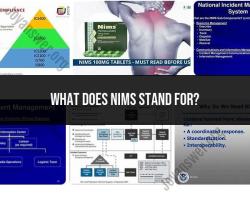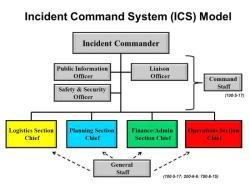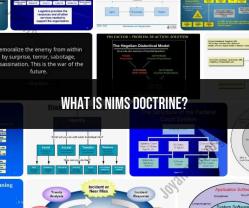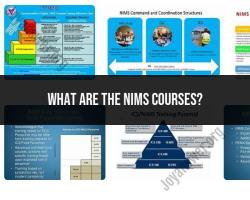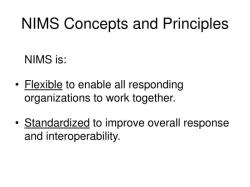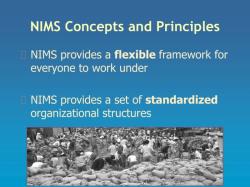Is ICS and Nims the same?
ICS (Incident Command System) and NIMS (National Incident Management System) are related concepts but are not exactly the same. Both ICS and NIMS are frameworks developed to enhance the effectiveness of incident management, especially in emergency response situations.
Incident Command System (ICS):
Definition:
- ICS is a standardized management system designed to enable effective and efficient incident management by providing a common structure for coordinating response efforts.
Focus:
- ICS primarily focuses on the management and coordination of on-scene incident activities, including response to emergencies such as fires, hazardous material spills, and natural disasters.
Key Components:
- ICS includes key components such as an Incident Commander, Operations Section, Planning Section, Logistics Section, and Finance/Administration Section. It organizes personnel, equipment, procedures, and communications within a standardized framework.
Scalability:
- ICS is scalable and can be adapted to incidents of varying sizes and complexities. It allows for a flexible and modular response structure.
National Incident Management System (NIMS):
Definition:
- NIMS is a comprehensive, nationwide framework for incident management that provides a systematic, proactive approach to guiding government agencies, non-profit organizations, businesses, and the public to work seamlessly during emergency incidents.
Focus:
- NIMS goes beyond the on-scene coordination covered by ICS. It addresses the entire spectrum of incident management, including preparedness, mitigation, response, and recovery.
Key Components:
- NIMS includes ICS as a key component within its framework. Additionally, it incorporates other elements such as the Multiagency Coordination System (MACS), the Public Information System (PIO), and the Joint Information System (JIS). NIMS establishes a standardized approach to emergency management that extends across all levels of government and various sectors.
Integration:
- NIMS emphasizes the integration of all levels of government (local, state, tribal, and federal) as well as private-sector organizations and non-profit entities in a unified effort.
Relationship:
Interconnectedness:
- ICS is a component of NIMS. In other words, ICS is the on-scene operational component that fits within the broader NIMS framework.
Complementary Roles:
- While ICS provides the organizational structure for managing incidents at the operational level, NIMS provides the overarching principles and guidelines for how different entities and agencies should work together at all levels of government and across disciplines.
National Standard:
- NIMS is considered a national standard for incident management in the United States, and federal funding is often tied to a jurisdiction's compliance with NIMS principles.
In summary, ICS is a specific component within the broader NIMS framework. ICS is focused on the on-scene management of incidents, providing a structure for command, control, and coordination. NIMS, on the other hand, encompasses the entire lifecycle of incident management and promotes a comprehensive, integrated approach across all levels of government and various organizations.
ICS vs. NIMS: Key Differences and Complementary Roles
1. Primary Differences:
Incident Command System (ICS):
- Focus: Provides a standardized on-site, all-hazards incident management structure for effective response and recovery.
- Scope: Primarily focuses on managing the incident itself, including tactical operations, resource allocation, and communication.
- Application: Primarily used by first responders and emergency personnel at incident scenes.
National Incident Management System (NIMS):
- Focus: Establishes a national framework for consistent incident management across all levels of government and participating organizations.
- Scope: Encompasses the entire incident management lifecycle, including preparedness, mitigation, response, recovery, and long-term planning.
- Application: Used by a wider range of stakeholders, including government agencies, non-governmental organizations, private sector entities, and volunteers.
2. Complementary Roles:
While distinct in their focus and application, ICS and NIMS work together to ensure effective emergency management:
- NIMS provides the overarching framework and standards for incident management.
- ICS serves as the operational system within the NIMS framework, implementing the standardized protocols at the incident scene.
- NIMS facilitates resource sharing and collaboration across different agencies and organizations.
- ICS ensures efficient and coordinated response operations within the incident.
3. Sector Usage:
ICS is primarily used by:
- Fire departments
- Law enforcement agencies
- Emergency medical services
- Hazardous materials response teams
- Search and rescue teams
NIMS is used by a wider range of sectors, including:
- All levels of government (federal, state, local)
- Non-governmental organizations (NGOs)
- Private sector companies
- Volunteer organizations
- Public health agencies
- Infrastructure and utility companies
In summary:
- ICS provides the tactical on-scene structure for managing emergencies.
- NIMS provides the overarching national framework and standards for all phases of incident management.
- Both systems work together to ensure coordinated, effective response and recovery from emergencies across all sectors.


